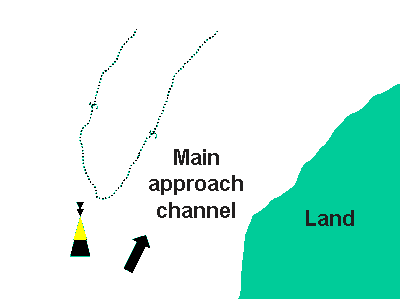In 1979, a body called International Association of Lighthouse Authorities (IALA) was formed to unify the World's buoyage system. They were largely successful, except we now have two similar systems, IALA 'A' and IALA 'B'.
The areas that use the 'B' system, are North and South America, Japan and the Philippines. The remainder of the World uses the 'A' system. We will concentrate on the 'A' system first, then look at the differences in the 'B' system.
The IALA systems are made up of five types of buoys, lateral cardinal, safe water, isolated danger and special.
In addition to the marks used in the IALA system, you will encounter navigation marks that do not follow this pattern. These will include: Lighthouses, Lightships, LANBYs (Large Automatic Navigation Buoys, generally replacing lightships), Light-floats (like a small light ship), Sectored lights and Leading lights.
Due to the change in the charts and practical almanac being used for RYA courses I am in the process of re-writing all the examples and questions. For those people who have the old charts (Chart 1 and 2 and PNT follow the Archive links where they exist, to access the old questions. The charts referred to here are being changed to the RYA Training Almanac - Northern
and Practice Charts 3 and 4. These are the charts used for the Day Skipper and Coastal Skipper/Yachtmaster theory courses, unfortunately at present I only plan to create examples for the northern hemisphere version of these charts.
The charts are included in the RYA Navigation Exercises 2nd edition
published by the RYA
Use of buoyage
It is important to remember that buoyage is only a guideline. An experienced skipper will use all their skills to assess how much faith to place in any navigational marks. There are several aspects that should be remembered:
The chart may not be up to date.
The lights may not be working or occasionally buoys marked as unlit on the chart may be lit!
The depth of the channel may have changed.
It is not possible to look at a buoy and know for certain where the channel is. An example is the south cardinal buoy marking the entrance to the River Hamble.

To enter the river, it is necessary to pass east of the buoy, when this is done, eventually the vessel will be in a position to the north of the latitude of the buoy. This may be thought to be contrary to the indication of the buoyage.
When the chart is consulted and the shape of the sea bed inspected, it is obvious that the buoy should be left to port when entering the harbour. The next navigational mark is an east cardinal beacon, which clarifies the situation marking the eastern side of the bank.
Sailtrain.co.uk is free to use, but if you feel you would like to contribute to the running and development costs you can donate via Paypal:
Additional Resources:

